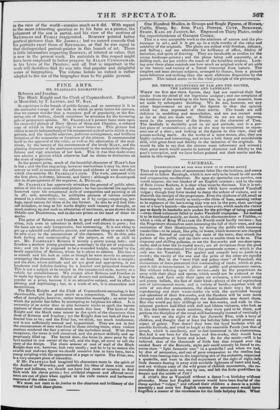FINE ARTS.
MR. FRADELLE'S ENGRAVINGS
Rebecca and Ivanhoe.
The Black Knight and the Clerk of Copmanhurst. Engraved in Mezzotint, by T. LUPTON, and W. SAY.
So capricious is the breath of public favour, and so necessary is it to the successful voyage of the bark in which an artist hoists his canvass, that we cannot wonder that a transient puff of popularity, or the flat- tering airs of fashion, should sometimes be mistaken for the favouring gale of permanent opinion. Mr. FRADELLE'S present fame rests upon his successful picture of Mary Queen of Scots and Chatelar, a reduced copy of which in line engraving is now before us. This picture had claims to merit independently of the ornamental style of art in which it was painted, and the tasteful selection, judicious arrangement, and brilliant imitation of the accessories or furniture of the picture. It recommended itself to the approval of the critic, as well as the admiration of the mul- titude, by the beauty of the countenance of the lovely DIARY, and 'the pleasing character of the sentiment conveyed in the melancholy thought- fulness and rapt attention of her look. This it was that made every one admire a picture which otherwise had no claims to distinction on the score of expression.
In the present print, much of the beautiful character of MARY'S face is lost ; and the line engraving, however meritorious it may be, does not convey so well as mezzotint the softness and richness of tone and effect which characterize Mr. FRADELLE's style. The work, compared with the first plate, is clumsy, laboured, and heavy ; although we do not speak this in disparagement of the engraver, A. DuNCAN.
Mr. FRADELLE has apparently mistaken the ground of public admi. ration of this his most celebrated picture : he has considered the applause bestowed upon his ornamental style of composition and painting as all in all ; and, accordingly, he multiplies pictures of various subjects treated in a similar style—nay, almost as if by recips---expecting, per- haps, equal success for them as for the former. In this he will find him- self mistaken, so long as his works display such vacancy of thought, so much making up, and such an affectation of sentiment, as are shown in his Othello and Desclemona; and in the two prints at the head of these re- marks.
The print of Rebecca and Ivanhoe is good and effective as a compo- sition, rich even to splendour in detail, and well-drawn in parts ; but the faces are not only inexpressive, but unmeaning. It is one thing to get up a splendid and effective picture, and another thing to make it tell its own story in the countenances of the characters. To do this, asks both feeling and understanding of the subject, as well as skill in art. Mr. FRADELLE'S Rebecca is merely a pretty young lady; and Ivanhoe a modern young gentleman, seemingly in the act of expostula- tion; and yet he is supposed to be a wounded knight, startled by the lovely apparition of Rebecca, whom he is about to address. His face is as smooth and his look as calm as though he were merely an amateur attempting the character. Rebecca is no heroine; her face is insipid ; and the Jew, whose attitude and air are good and appropriate, is too handsome and holyday-looking for a hunted and persecuted Israelite. This is not a subject to be treated in the ornamental style, merely as a vehicle for embellishment. We cannot allow Rebecca and Ivanhoe to be made lay figures for the display of dresses and attitudes. It may be popular as a print, because it is an attractive subject, and its effect is pleasing and captivating ; but, as a work of art, it is emasculate and meretricious.
The Black Knight and the Clerk of Copmanhurst carousing, is less objectionable, and has great merit as a composition. The intended effect of lamplight, however, rather resembles moonlight ; an error into which the painter has fallen by attempting to heighten his effect. It is unworthy of an artist thus to play fantastic tricks to catch the barren applause of those whose admiration needs this lure. The faces of the Knight and the Monk come nearer to the spirit of the characters than those of Rebecca and Ivanhoe; yet the Knight does not look all that we fancied him to be ; and the Friar has, we think, too much bonhommie, and is not sufficiently sensual and hypocritical. They are not in fact the countenances of men who lived in those stirring times, when violent passions rendered the face a mirror of the turbulent mind. With these exceptions, the scene is well conceived, and the picture skilfully and ap- propriately filled up. The barred door, the horse (a mere pony by the bye) stabled in one corner of the cell, and the dogs, all serve to tell the story of the design. The chain armour or coat of mail of the Black Knight does not, however, look very steeply ; and he is by no means the swarth and stalwart figure we should conceive him to have been, but a young stripling with the appearance of a page or squire. The Friar, too, is a very compact piece of rotundity. If Mr. FRADELLE had imagined his characters more in the spirit of the Author of Waverley, and embodied his ideas of "them with more vigour and boldness, we should not have had room or occasion to find fault with his clever prints ; but artificial elegance and affected send- ment are out.of place when applied to the rude nature and barbarous mannerssof.the olden time.
We must not omit to do justice to the clearness and brilliancy of the mezzotint of both these plates.


























 Previous page
Previous page